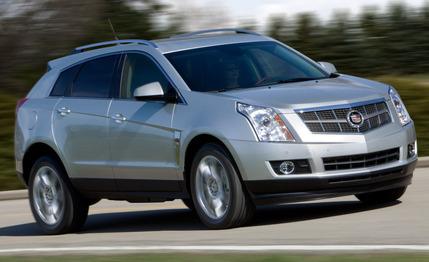
 First Drive Review
First Drive Review
We’ve never kept our love for the previous Cadillac SRX a secret. It’s been one of our favorite so-called crossover SUVs since it launched in 2004 and won several of our 5Best truck awards. It consistently placed at the top of comparison tests even after several years on the market. In 2007, well into its life cycle, the SRX received a handsome new interior, and in a $50,000-SUV comparison test against the Land Rover LR3, Volkswagen Touareg V-6, Volvo XC90 V-8, Lexus GX470, Mercedes-Benz ML350, BMW X5 3.0si, and Acura MDX, the Caddy’s road manners, speed, and handling led us to rank it second only to the then-new MDX.
Back to the Drawing Board
So now we have a second-generation SRX, and Cadillac has moved away from the rear-drive, longitudinal-engine layout of the previous SRX. Basically, the first-gen SRX was a high-roof wagon version of the CTS sports sedan and, consequently, drove much like one, which is exactly why we loved it so much. On the practicality front, that first SRX had seating for seven, could tow up to 4250 pounds, didn’t cost a bundle, and once its interior was redesigned, it became a bona fide luxury truck. Despite our glowing reviews and various accolades, sales of the original never quite took off, especially when compared with the segment’s bestseller, the Lexus RX350. In search of more customers, Cadillac has redesigned the SRX and aimed it squarely at the Lexus.
Gone is the rear-wheel-drive/all-wheel-drive platform. In its place is a front-drive-based arrangement with a transversely mounted engine, just like the RX. We’ve already tested the base engine in the SRX 3.0, a direct-injected 3.0-liter V-6 with 265 hp and 223 lb-ft of torque, and found it good enough to get the 4500-pound SRX to 60 mph in 8.4 seconds. We complained about an unresponsive throttle calibration. Cadillac has since reworked it for better responsiveness. After a brief drive in a “fixed” 3.0-liter, we can say that it indeed responds with greater gusto. But the base engine stays busy under the SRX’s hood. Mostly, it comes down to its paltry 223 lb-ft of torque that are delivered at a high 5100 rpm. Just getting the engine to rev to its torque peak is a long and laborious process.
More Power, Please
Enter the optional 300-hp, 2.8-liter turbo V-6 in the SRX 2.8T, which will become available in October. Cadillac predicts a 0-to-60 time of 7.6 seconds, and that seems believable from the seat of our pants. It might not be a huge improvement over the 8.4 seconds we recorded in the 3.0-liter, but acceleration from low revs feels far better. The turbo engine builds revs quicker, and its 295 lb-ft of torque hustle the SRX with greater enthusiasm without having to resort to revving the engine to its redline. The torque peak arrives at a low 2000 rpm and remains steady until about 5000 rpm.
Our drive of the SRX 2.8T didn’t allow us to measure its performance, but after driving the turbocharged SRX, we have no doubt regarding Cadillac’s claims. We will, however, be testing the SRX 2.8T in the coming months. Even with the expected decrease in acceleration times, if the SRX 2.8T had been available for our last comparison test of $40,000 luxury SUVs, its claimed acceleration would have placed it nearly a second behind the group average, making it the slowest in the group.
The turbocharged V-6 is a smooth customer and doesn’t emit any untoward noises, even as the turbocharger forces up to 11 psi into the intake tract. Driven back-to-back, we believe the 3.0-liter V-6 sounds grittier and far more stressed with its 4500-pound burden than the turbo six does, especially as it approaches redline. Fuel economy for the 2.8-liter turbo is nearly identical to the all-wheel-drive 3.0-liter’s city and highway ratings of 17 and 23 mpg; Cadillac’s preliminary numbers indicate that city fuel economy will drop by one, to 16 mpg, for the 2.8T. The only advantages of the 3.0-liter we could discern are that it costs less and requires regular unleaded. Cadillac recommends premium fuel to get the most out of the turbocharged V-6.
Credible and Competitive
As the top choice in the SRX hierarchy, the SRX 2.8T comes comprehensively equipped. The aforementioned all-wheel drive is standard, as is the excellent FE3 suspension setting that brings continuously variable shocks made by Sachs (these aren’t the active magnetic shocks that are available in some other GM products). Even on its standard 20-inch wheels, the SRX 2.8T feels composed and compliant. Body motions and roll are kept in check, and the SRX feels more Germanic, precise, and stable than the Lexus RX. Luxury items such as heated leather seats, dual-zone climate control, navigation, and a giant sunroof are all standard. The only options are chrome versus painted wheels, keyless entry and start, cooled seats, and a rear-seat entertainment system.
Pricing for the SRX 2.8T has not yet been set, but Cadillac expects it to begin just below $50,000, or about $3000 higher than a comparable 3.0-liter SRX. The new engine doesn’t turn the SRX into a dragster, but it does make its acceleration at least class competitive. Where the Cadillac really shines is in its suspension tuning, quiet demeanor, nearly complete list of standard equipment, and attractive interior. We still miss the distinctly sports-sedan feel of the previous SRX, and we’ve never professed much passion for the Lexus RX that the new version attempts to ape, but the turbocharged engine in the SRX makes it a credible and compelling alternative.